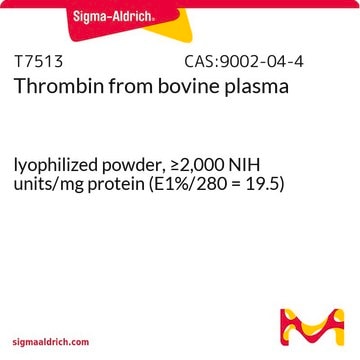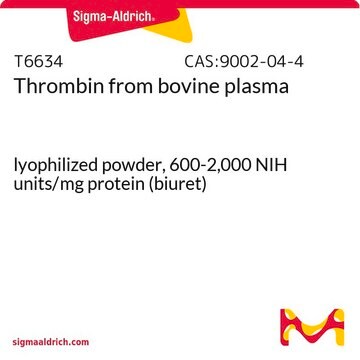RECOMT
Thrombin CleanCleave™ Kit
Synonyme(s) :
Thrombin Cleavage Kit
About This Item
Produits recommandés
Forme
suspension
Poids mol.
37 kDa
Technique(s)
protein purification: suitable
Conditions d'expédition
wet ice
Température de stockage
2-8°C
Description générale
Application
Caractéristiques et avantages
- Fast, efficient cleavage in as little as 2 hours
- Thrombin is covalently bound to agarose for easy removal.
- The robust cleavage reaction is effective at temperatures from 4 °C to 37 °C and over a wide range of pH and ionic strengths.
- Cleave tags even in the presence of 0.1% Triton™, 1 M urea or 5 mM EDTA
- Thrombin-agarose is reusable.
Quantité
Informations légales
Composants de kit seuls
- Thrombin Cleavage Buffer, 10× 10 mL
Produit(s) apparenté(s)
Code de la classe de stockage
10 - Combustible liquids
Point d'éclair (°F)
Not applicable
Point d'éclair (°C)
Not applicable
Certificats d'analyse (COA)
Recherchez un Certificats d'analyse (COA) en saisissant le numéro de lot du produit. Les numéros de lot figurent sur l'étiquette du produit après les mots "Lot" ou "Batch".
Déjà en possession de ce produit ?
Retrouvez la documentation relative aux produits que vous avez récemment achetés dans la Bibliothèque de documents.
Les clients ont également consulté
Articles
This page shows how to cleave and purify GST-tagged proteins bound to GSTrap from Cytiva.
Protocoles
This page how to remove GST tags by enzymatic cleavage using Cytiva products.
Notre équipe de scientifiques dispose d'une expérience dans tous les secteurs de la recherche, notamment en sciences de la vie, science des matériaux, synthèse chimique, chromatographie, analyse et dans de nombreux autres domaines..
Contacter notre Service technique










